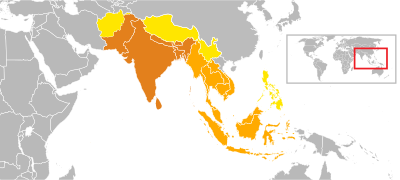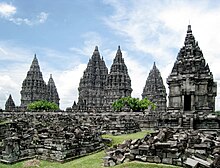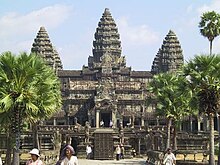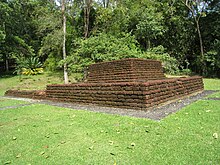Greater India
Greater India

Greater India was the historical extent of the culture of India beyond the Indian subcontinent. This particularly concerns the spread of Hinduism and Buddhism,[1] and the spread of the Indian writing systems like the Pallava script of the south Indian Pallava dynasty[2][3] by the travellers and maritime traders of the 5th to 15th centuries, but may also refer to the spread of Hinduism and Buddhism from India to Central Asia and China by the Silk Road during the early centuries of the Common Era. To the west, Greater India overlaps with Greater Persia in the Hindu Kush and Pamir Mountains. The term is tied to the geographic uncertainties surrounding the "Indies" during the Age of Exploration.
Contents
Definition and nomenclature

North West India is part of the Vedic Sanskrit Sarasvatī- culture area that included the ancient satrapies of: Aria (Herat); Arachosia (Kandahar, Lashkar Gah, and Quetta), Gedrosia; Bactriana (Balkh); Sattagydia (Ghazni); and Gandhara (Kabul, Jalalabad, Peshawar).[4] Greater North West India as part of the Vedic religion that consisted of countries Pakistan, Afghanistan, Uzbekistan, Tajikistan, West China, Kyrgyzstan and Balochistan and Khorasan Iran, Greater Khorasan those states where called in Sanskrit by special names and where known as Bactrian, Soghdian, and Tokharian states. In Uzbekistan, Tajikistan, Kyrgyzstan are full of ancient Buddistic art, wall paintings and statues, their museums have opened for exhibition. In medieval Europe the concept of "three Indias" was in common circulation. Greater India was the southern part of South Asia, Lesser India was the northern part of South Asia, and Middle India was the region around Ethiopia.[5] The name Greater India (Portuguese: India Maior[6][7]) was used at least from the mid-15th century.[7] The term, which seems to have been used with variable precision,[8] sometimes meant only the Indian subcontinent;[9] Europeans used a variety of terms related to South Asia to designate the South Asian peninsula, including High India, Greater India, Exterior India and India aquosa.[10]
However, in some accounts of European nautical voyages, Greater India (or India Major) extended from the Malabar Coast (present-day Kerala) to India extra Gangem[11] (lit. "India, beyond the Ganges," but usually the East Indies, i.e. present-day Malay Archipelago) and India Minor, from Malabar to Sind.[12] Farther India was sometimes used to cover all of modern Southeast Asia and sometimes only the mainland portion.[10]
In late 19th-century geography "Greater India" referred to Hindustan (Northwestern Subcontinent) which included the Punjab, the Himalayas, and extended eastwards to Indochina (including Burma), parts of Indonesia (namely, the Sunda Islands, Borneo and Celebes), and the Philippines."[13] German atlases sometimes distinguished Vorder-Indien (Anterior India) as the South Asian peninsula and Hinter-Indien as Southeast Asia.[10]
In plate tectonic models of the India–Asia collision, "Greater India" signifies "the Indian sub-continent plus a postulated northern extension".[14] Although its usage in geology pre-dates plate tectonic theory,[15] the term has seen increased usage since the 1970s.
Indianised kingdoms

The concept of the Indianised kingdoms, first described by George Coedès, is based on Hindu and Buddhist cultural and economic influences in Southeast Asia.[16] Butuan, Champa, Dvaravati, Funan, Gangga Negara, Kadaram, Kalingga, Kutai, Langkasuka, Pagan, Pan Pan, Po-ni, Tarumanagara and Tondo were among the earliest Hindu kingdoms in Southeast Asia, established around the 1st to 4th centuries CE. Despite being culturally akin to Hindu cultures, these kingdoms were indigenous and independent of the Indian mainland. States such as Srivijaya, Majapahit and the Khmer empire developed territories and economies that rivaled those in India itself. Borobudur in Java, for example, is the largest Buddhist monument ever built.[17] Coedès has been criticised for understating the Southeast Asian element of these kingdoms, in an unconscious echo of the European "civilising mission."[18]
Professor Robert Lingat — characterised by law professor John Henry Wigmore as the greatest (and almost the only) authority on Siamese legal history[19] — tended to emphasise the contribution of Southeast Asian societies and rulers to the formation of these states. In particular, where Coedès saw Indian merchants as the founders of these states, Lingat saw Southeast Asian rulers as founding them and then importing Indian ritual specialists as advisers on rajadharma, or the practices of Indian kingship. This view is supported by the argument that Indian merchants would not have possessed the ritual knowledge which became so prominent in these kingdoms.[20]
These Indianised kingdoms developed a close affinity with and internalised Indian religious, cultural and economic practices without significant direct input from Indian rulers themselves. The issue remains controversial; Quaritch Wales in particular is cited[21] as holding that Indianisation was the work of Indian traders and merchants as opposed to political leaders, although the travels of Buddhist monks such as Atisha later became important. There was also a merchant named Magadu, known to history as Wareru and founder of the Hanthawaddy Kingdom, who commissioned Mon specialists in Indian traditions to compile the Code of Wareru, which has formed the basis for Burmese common law down to the present. Most Indianised kingdoms combined both Hindu and Buddhist beliefs and practices in a syncretic manner. Kertanagara, the last king of Singhasari, described himself as “Sivabuddha”, a simultaneous incarnation of the Hindu god Shiva and the Buddha.[22]
Southeast Asian rulers enthusiastically adopted elements of rajadharma (Hindu and Buddhist beliefs, codes, and court practices) to legitimise their own rule and constructed cities, such as Angkor, to affirm royal power by reproducing a map of sacred space derived from the Ramayana and Mahabharata. Southeast Asian rulers frequently adopted lengthy Sanskrit titles and founded cities, such as Ayutthaya in Thailand, named after those in the Indian epics.
Cultural and trading relations between the powerful Chola dynasty of South India and the Southeast Asian Hindu kingdoms led the Bay of Bengal to be called "The Chola Lake", and the Chola attacks on Srivijaya in the 10th century CE are the sole example of military attacks by Indian rulers against Southeast Asia. The Pala dynasty of Bengal, which controlled the heartland of Buddhist India, maintained close economic, cultural and religious ties, particularly with Srivijaya.
Individual kingdoms
- Langkasuka (-langkha Sanskrit for "resplendent land" -sukkha of "bliss") was an ancient Hindu kingdom located in the Malay Peninsula. The kingdom, along with Old Kedah settlement, are probably the earliest territorial footholds founded on the Malay Peninsula. According to tradition, the founding of the kingdom happened in the 2nd century; Malay legends claim that Langkasuka was founded at Kedah, and later moved to Pattani.
- Funan was a pre-Angkor Cambodian kingdom, located around the Mekong delta, probably established by Mon–Khmer settlers speaking an Austroasiatic language. According to reports by two Chinese envoys, K'ang T'ai and Chu Ying, the state was established by an Indian Brahmin named Kaundinya, who in the 1st century CE was given instruction in a dream to take a magic bow from a temple and defeat a Khmer queen, Soma. Soma, the daughter of the king of the Nagas, married Kaundinya and their lineage became the royal dynasty of Funan. The myth had the advantage of providing the legitimacy of both an Indian Brahmin and the divinity of the cobras, who at that time were held in religious regard by the inhabitants of the region.
- From the 7th to 13th centuries Srivijaya, a maritime empire centred on the island of Sumatra in Indonesia, had adopted Mahayana and Vajrayana Buddhism under a line of rulers from Dapunta Hyang Sri Jayanasa to the Sailendras. A stronghold of Vajrayana Buddhism, Srivijaya attracted pilgrims and scholars from other parts of Asia. I Ching reports that the kingdom was home to more than a thousand Buddhist scholars. A notable Buddhist scholar of local origin, Dharmakirti, taught Buddhist philosophy in Srivijaya and Nalanda, and was the teacher of Atisha. Most of the time, this Buddhist Malay empire enjoyed cordial relationship with China and the Pala Empire in Bengal, and the 860 Nalanda inscription records that maharaja Balaputra dedicated a monastery at the Nalanda university in Pala territory. The Empire of Srivijaya declined due to Muslim attacks and conversions.
- Medang flourished between the 8th and 11th centuries. It was first centred in central Java before later moving to east Java. This kingdom produced numbers of Hindu-Buddhist temples in Java, including Borobudur Buddhist mandala and Prambanan Trimurti Hindu temple dedicated mainly for Shiva. The Sailendras are the ruling family of this kingdom in an earlier stage in central Java before replaced by the Isyana Dynasty.
- The kingdom of Champa (or Lin-yi in Chinese records) controlled what is now south and central Vietnam from approximately 192 through 1697. The dominant religion of the Cham people was Hinduism and the culture was heavily influenced by India. It was later conquered by the sinicized Vietnamese, then known as Dai Viet (大越).
- Later, from the 9th to the 13th centuries, the Mahayana Buddhist and Hindu Khmer empire dominated much of the South-East Asian peninsula. Under the Khmer, more than 900 temples were built in Cambodia and in neighbouring Thailand. Angkor was at the centre of this development, with a temple complex and urban organisation able to support around one million urban dwellers. The largest temple complex of the world, Angkor Wat, stands here; built by the king Vishnuvardhan, a king of the dynasty that believed themselves to be incarnations of Vishnu.
- Mon kingdoms from the 9th century until the abrupt end of the Hanthawaddy Kingdom in 1539, were notable for facilitating Indianzed cultural exchange in lower Burma, in particular by having strong ties with Ceylon.
- The Javanese Majapahit empire centred in East Java succeeded the Singhasari empire and flourished in Indonesian archipelago between the 13th and 15th centuries. Noted for their naval expansion spanned west—east from Lamuri in Aceh to Wanin in Papua, Majapahit was one of the last and greatest Hindu empires in Maritime Southeast Asia. Most of Balinese Hindu culture, traditions and civilisations were derived from Majapahit legacy, since numbers of Majapahit nobles, priests, and artisans find their home in Bali after the decline of Majapahit to Islamic Demak Sultanate.
- Kingdom of Tondo Originally an Indianized kingdom in the 10th century, Tondo built upon and capitalized on being central to the long-existing ancient regional trading routes throughout the archipelago to include among others, initiating diplomatic and commercial ties with China during the Ming Dynasty. Thus it became an established force in trade throughout Southeast Asia and East Asia.
Indian cultural sphere

The use of Greater India to refer to an Indian cultural sphere was popularised by a network of Bengali scholars in the 1920s who were all members of the Calcutta-based Greater India Society. The movement's early leaders included the historian R. C. Majumdar (1888–1980); the philologists Suniti Kumar Chatterji (1890–1977) and P. C. Bagchi (1898–1956), and the historians Phanindranath Bose and Kalidas Nag (1891–1966).[23][24]
Some of their formulations were inspired by concurrent excavations in Angkor by French archaeologists and by the writings of French Indologist Sylvain Lévi. The scholars of the society postulated a benevolent ancient Indian cultural colonisation of Southeast Asia, in stark contrast—in their view—to the colonialism of the early 20th century.[25][26][27]

The term Greater India and the notion of an explicit Hindu colonisation of ancient Southeast Asia have been linked to both Indian nationalism[28] and Hindu nationalism.[29] However, many Indian nationalists, like Jawaharlal Nehru and Rabindranath Tagore, although receptive to "an idealisation of India as a benign and uncoercive world civiliser and font of global enlightenment,"[30] stayed away from explicit "Greater India" formulations.[31] In addition, some scholars have seen the Hindu/Buddhist acculturation in ancient Southeast Asia as "a single cultural process in which Southeast Asia was the matrix and South Asia the mediatrix."[32] In the field of art history, especially in American writings, the term survived longer due to the influence of art theorist Ananda Coomaraswamy. Coomaraswamy's view of pan-Indian art history was influenced by the "Calcutta cultural nationalists."[33]
By some accounts Greater India consists of "lands including Burma, Java, Cambodia, Bali, and the former Champa and Funan polities of present-day Vietnam,"[34] in which pre-Islamic Indian culture left an "imprint in the form of monuments, inscriptions and other traces of the historic "Indianising" process."[34] By some other accounts, many Pacific societies and "most of the Buddhist world including Ceylon, Tibet, Central Asia, and even Japan were held to fall within this web of Indianising culture colonies"[34] This particular usage—implying cultural "sphere of influence" of India—was promoted by the Greater India Society, formed by a group of Bengali men of letters,[35] and is not found before the 1920s. The term Greater India was used in historical writing in India into the 1970s.[36]
Cultural expansion
From about the 1st century, India started to strongly influence Southeast Asian countries. Trade routes linked India with southern Burma, central and southern Siam, lower Cambodia and Champa (modern day Southern Vietnam) and numerous urbanised coastal settlements were established there.
For more than a thousand years, Indian Hindu/Buddhist influence was therefore the major factor that brought a certain level of cultural unity to the various countries of the region. The Pali and Sanskrit languages and the Indian script, together with Theravada and Mahayana Buddhism, Brahmanism and Hinduism, were transmitted from direct contact as well as through sacred texts and Indian literature, such as the Ramayana and the Mahabharata epics.
From the 5th to the 13th centuries, South-East Asia had very powerful Indian colonial empires and became extremely active in Buddhist architectural and artistic creation. The Sri Vijaya Empire to the south and the Khmer Empire to the north competed for influence.
A defining characteristic of the cultural link between South East Asia and the Indian subcontinent is the spread of ancient Indian Vedic/Hindu and Buddhist culture and philosophy into Myanmar, Thailand, Indonesia, Malaya, Laos and Cambodia. Indian scripts are found in South East Asian islands ranging from Sumatra, Java, Bali, south Sulawesi and most of the Philippines.[37]
Cultural commonalities
The diffusion of Indian culture is demonstrated with the following examples:
Religion, mythology and folklore
- Hinduism is practised by the majority of Bali's population.[40]
- Garuda, a Hindu mythological figure, is present in the coats of arms of Indonesia, Thailand and Ulan Bator.
- Kaharingan, an indigenous religion followed by the Dayak people of Borneo, is categorised as a form of Hinduism in Indonesia.
- Philippine mythology includes the supreme god Bathala and the concept of Diwata and the still-current belief in Karma—all derived from Hindu-Buddhist concepts.
- Malay folklore contains a rich number of Indian-influenced mythological characters, such as Bidadari, Jentayu, Garuda and Naga.
- Wayang shadow puppets and classical dance-dramas of Indonesia, Cambodia and Thailand took stories from episodes of Ramayana and Mahabharata.
Architecture and monuments
- The same style of Hindu temple architecture was used in several ancient temples in South East Asia including Angkor Wat, which was dedicated to Hindu god Vishnu and is shown on the flag of Cambodia, also Prambanan in Central Java, the largest Hindu temple in Indonesia, is dedicated to Trimurti — Shiva, Vishnu and Brahma.
- Borobudur in Central Java, Indonesia, is the world's largest Buddhist monument. It took shape of a giant stone mandala crowned with stupas and believed to be the combination of Indian-origin Buddhist ideas with the previous megalithic tradition of native Austronesian step pyramid.
- The minarets of 15th- to 16th-century mosques in Indonesia, such as the Great Mosque of Demak and Kudus mosque resemble those of Majapahit Hindu temples.
- The Batu Caves in Malaysia are one of the most popular Hindu shrines outside India. It is the focal point of the annual Thaipusam festival in Malaysia and attracts over 1.5 million pilgrims, making it one of the largest religious gatherings in history.[41]
- Erawan Shrine, dedicated to Brahma, is one of the most popular religious shrines in Thailand.[42]
Language
- Indonesian, Javanese and Malaysian have absorbed a large amount of Sanskrit loanwords into their respective lexicons (see: Sanskrit loan words in Indonesian). Many languages of native lowland Filipinos such as Tagalog, Ilocano[43] and Visayan[44] contain numerous Sanskrit loanwords.
- Many Indonesian names have Sanskrit origin (e.g. Dewi Sartika, Megawati Sukarnoputri, Susilo Bambang Yudhoyono, Teuku Wisnu).
- Street signs in Yogyakarta and other major cities in Indonesia are written in Pallava-derived Javanese script.
- The name of the King of Thailand, Bhumibol Adulyadej, can be written in Sanskrit.[45]
Toponym
- Several of Indonesian toponyms has Indian parallel or origin, such as Madura with Mathura, Serayu and Sarayu river, Semeru with Sumeru mountain, Kalingga from Kalinga Kingdom, and Ngayogyakarta from Ayodhya.
- Siamese ancient city of Ayutthaya also derived from Ramayana's Ayodhya.
- Names of places could simply renders their Sanskrit origin, such as Singapore, from Singapura (Singha-pura the "lion city"), Jakarta from Jaya and kreta ("complete victory").
- Some of Indonesian regencies such as Indragiri Hulu and Indragiri Hilir derived from Indragiri River, Indragiri itself means "mountain of Indra".
- Some Thai toponyms also often have Indian parallels or Sanskrit origin, although the spellings are adapted to the Siamese tongue, such as Ratchaburi from Raja-puri ("king's city"), Buriram from Puri-Rama ("city of Rama"), and Nakhon Si Thammarat from Nagara Sri Dharmaraja.
- The tendency to use Sanskrit for modern neologism also continued to modern day. In 1962 Indonesia changed the colonial name of New Guinean city of Hollandia to Jayapura ("glorious city"), Orange mountain range to Jayawijaya Mountains.
- While Malaysia named their new government seat as Putrajaya ("prince of glory") in 1999.
Linguistic influence
Scholars like Sheldon Pollock have used the term Sanskrit Cosmopolis to describe the region, and argued for millennium-long cultural exchanges without necessarily involving migration of peoples or colonisation. Pollock's 2006 book The Language of the Gods in the World of Men makes a case for studying the region as comparable with Latin Europe and argues that the Sanskrit language was its unifying element.
Sanskrit and related languages have also influenced their Sino-Tibetan-speaking neighbours to the north through the spread of Buddhist texts in translation.[46] Buddhism was spread to China by Mahayanist missionaries sent by Emperor Ashoka mostly through translations of Buddhist Hybrid Sanskrit and Classical Sanskrit texts, and many terms were transliterated directly and added to the Chinese vocabulary. (Although Buddhist Hybrid Sanskrit is not Sanskrit, properly speaking, its grammar and vocabulary are substantially the same, both because of genetic relationship, and because of conscious implementation of Pāṇinian standardizations on the part of composers. Buddhist texts composed in Sanskrit proper were primarily found in philosophical schools like the Madhyamaka.) The situation in Tibet is similar; many Sanskrit texts survive only in Tibetan translation (in the Tanjur).
In Southeast Asia, languages such as Thai and Lao contain many loan words from Sanskrit, as do Khmer to a lesser extent, through Sinified hybrid Sanskrit. For example, in Thai, the Rāvana—the emperor of Sri Lanka is called 'Thosakanth' which is a derivation of his Sanskrit name 'Dashakanth' ("of ten necks").
Many Sanskrit loanwords are also found in Austronesian languages, such as Javanese particularly the old form from which nearly half the vocabulary is derived from the language.[47] [48] Other Austronesian languages, such as traditional Malay, modern Indonesian, also derive much of their vocabulary from Sanskrit, albeit to a lesser extent, with a large proportion of words being derived from Arabic. Similarly, Philippine languages such as Tagalog have many Sanskrit loanwords.
A Sanskrit loanword encountered in many Southeast Asian languages is the word bhāṣā, or spoken language, which is used to mean language in general, for example bahasa in Malay, Indonesian and Tausug, basa in Javanese, Sundanese, and Balinese, phasa in Thai and Lao, bhasa in Burmese, and phiesa in Khmer.




